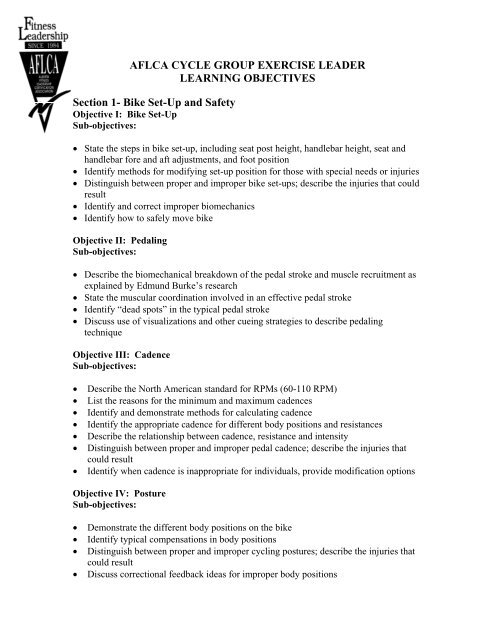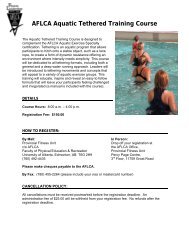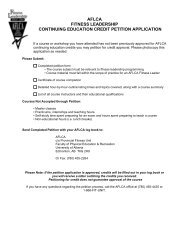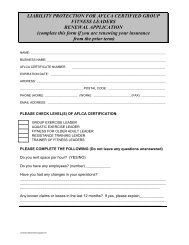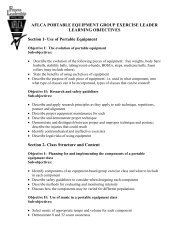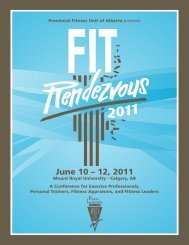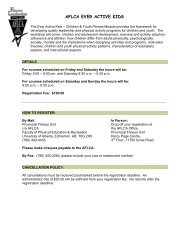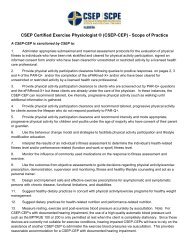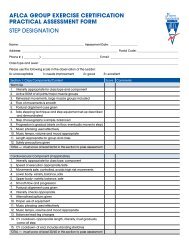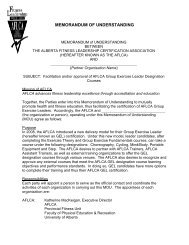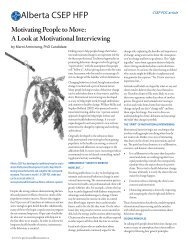AFLCA CYCLE GROUP EXERCISE LEADER LEARNING ...
AFLCA CYCLE GROUP EXERCISE LEADER LEARNING ...
AFLCA CYCLE GROUP EXERCISE LEADER LEARNING ...
Create successful ePaper yourself
Turn your PDF publications into a flip-book with our unique Google optimized e-Paper software.
<strong>AFLCA</strong> <strong>CYCLE</strong> <strong>GROUP</strong> <strong>EXERCISE</strong> <strong>LEADER</strong><br />
<strong>LEARNING</strong> OBJECTIVES<br />
Section 1- Bike Set-Up and Safety<br />
Objective I: Bike Set-Up<br />
Sub-objectives:<br />
• State the steps in bike set-up, including seat post height, handlebar height, seat and<br />
handlebar fore and aft adjustments, and foot position<br />
• Identify methods for modifying set-up position for those with special needs or injuries<br />
• Distinguish between proper and improper bike set-ups; describe the injuries that could<br />
result<br />
• Identify and correct improper biomechanics<br />
• Identify how to safely move bike<br />
Objective II: Pedaling<br />
Sub-objectives:<br />
• Describe the biomechanical breakdown of the pedal stroke and muscle recruitment as<br />
explained by Edmund Burke’s research<br />
• State the muscular coordination involved in an effective pedal stroke<br />
• Identify “dead spots” in the typical pedal stroke<br />
• Discuss use of visualizations and other cueing strategies to describe pedaling<br />
technique<br />
Objective III: Cadence<br />
Sub-objectives:<br />
• Describe the North American standard for RPMs (60-110 RPM)<br />
• List the reasons for the minimum and maximum cadences<br />
• Identify and demonstrate methods for calculating cadence<br />
• Identify the appropriate cadence for different body positions and resistances<br />
• Describe the relationship between cadence, resistance and intensity<br />
• Distinguish between proper and improper pedal cadence; describe the injuries that<br />
could result<br />
• Identify when cadence is inappropriate for individuals, provide modification options<br />
Objective IV: Posture<br />
Sub-objectives:<br />
• Demonstrate the different body positions on the bike<br />
• Identify typical compensations in body positions<br />
• Distinguish between proper and improper cycling postures; describe the injuries that<br />
could result<br />
• Discuss correctional feedback ideas for improper body positions
Section 2- Class Structure and Content<br />
Objective I: Planning for and implementing the components of an indoor cycling<br />
group exercise class<br />
Sub-objectives:<br />
• Identify components of an indoor cycling group exercise class and what to include in<br />
each component<br />
• Describe safety guidelines to consider when designing each component<br />
• Describe methods for evaluating and monitoring intensity<br />
• Identify the appropriate needs of stretching during different components of class (ie.<br />
warm-ups, cardiovascular cooldowns and flexibility/relaxation)<br />
• Demonstrate different types of stretching (i.e. static, dynamic)<br />
• Identify those stretches which safely use the bike for assistance<br />
• Identify the priorities in stretching to complement the riding postures and muscle<br />
activation of the class<br />
Objective II: Use of music in an indoor cycling group exercise class<br />
Sub-objectives:<br />
• List reasons for using music in an indoor cycling class<br />
• Identify the relationship between music and motivation<br />
• Differentiate cycling music elements from other group exercise music<br />
• Describe the use of music to assist cadence<br />
• Identify where to find appropriate and legal indoor cycling class music<br />
Objective III: Clothing and Footwear<br />
Sub-objectives:<br />
• Explain the benefits and reasons for wearing cycle shorts<br />
• Identify the benefits and features of a cycling shoe<br />
Section 3- Leadership and Choreography Design<br />
Objective I: Outdoor cycling elements<br />
Sub-objectives:<br />
• Describe the effects of outdoor cycling (i.e. drafting, wind resistance, road tension,<br />
center of gravity over bike)<br />
• Discuss the elements of racing (i.e. team elements, competition, time trialing, sprints)<br />
• Describe typical cycling terms (i.e. hammering, cranking)
Objective II: Cardiovascular conditioning/drills<br />
Sub-objectives:<br />
• Distinguish between different types of cardiovascular conditioning: max aerobic<br />
power, lactate threshold, aerobic efficiency, specific strength, peak power<br />
• Describe how these cardiovascular conditioning types relate to drills and program<br />
design<br />
• Identify the training/cardiovascular conditioning effect of each drill<br />
• Describe the importance of the interval/rest ratio, and how to effectively incorporate<br />
into program design<br />
• Identify precautions that would be utilized for different participants and drills<br />
Objective III: Movement combinations/choreography design<br />
Sub-objectives:<br />
• Prepare effective lesson plans<br />
• Evaluate lesson plans using established methods and training principles<br />
• Identify how to plan a class and create class profiles<br />
• Describe different bike layouts and how they impact class design<br />
• Identify methods for setting a focus or goal for a class<br />
Objective IV: Instruction, cueing and leadership<br />
• Describe ways to identify with audience and connect with participants<br />
• Describe how to observe, respond and adapt to participant needs<br />
• Demonstrate good verbal and visual cueing skills<br />
• Describe how to set an enthusiastic, motivational environment in an indoor cycling<br />
setting<br />
• Demonstrate effective feedback techniques<br />
• List the instructional challenges specific to indoor cycling


